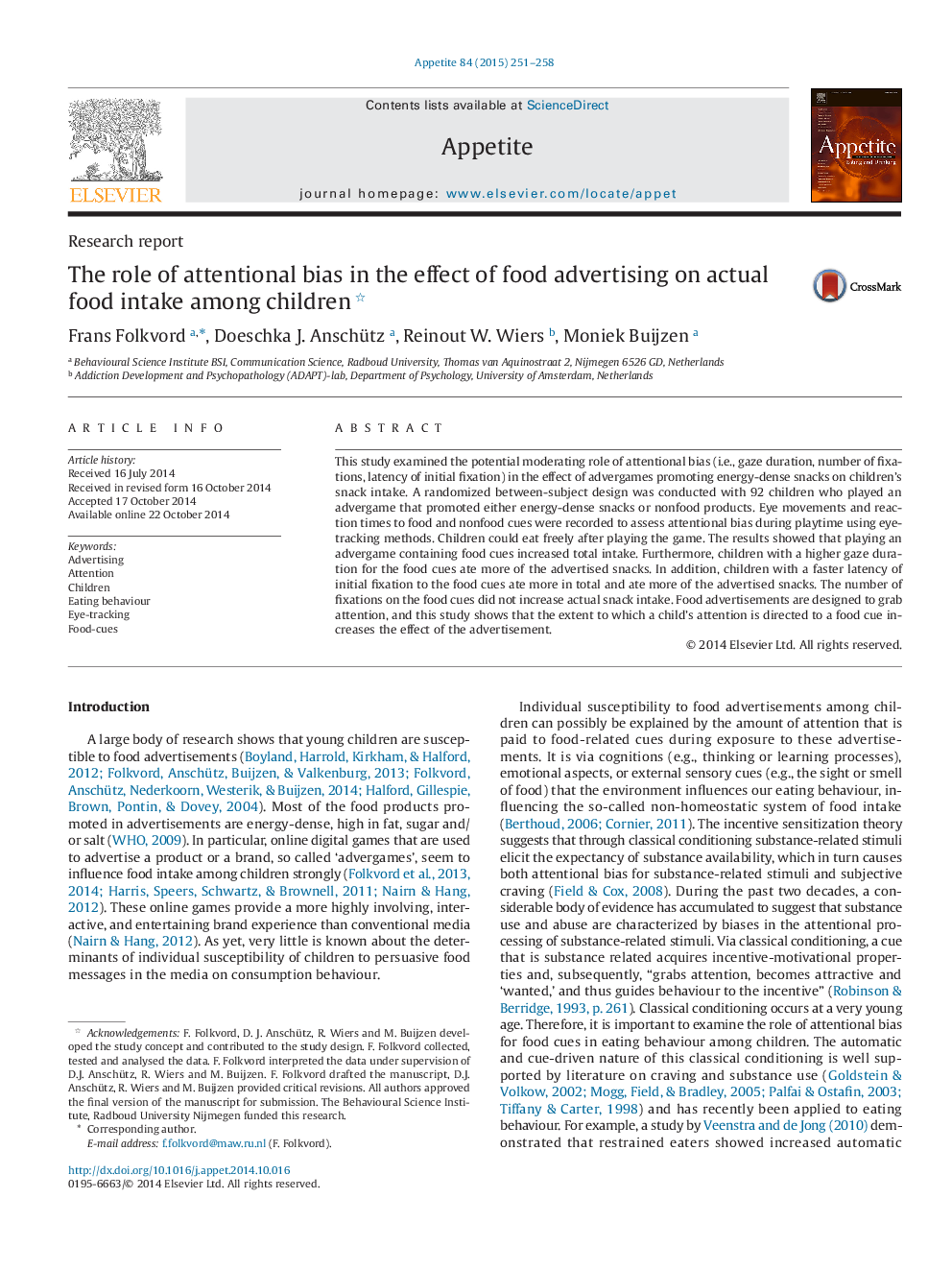| کد مقاله | کد نشریه | سال انتشار | مقاله انگلیسی | نسخه تمام متن |
|---|---|---|---|---|
| 7309772 | 1475396 | 2015 | 8 صفحه PDF | دانلود رایگان |
عنوان انگلیسی مقاله ISI
The role of attentional bias in the effect of food advertising on actual food intake among children
ترجمه فارسی عنوان
نقش تعصب توجه در اثر تبلیغات غذایی بر مصرف واقعی غذا در کودکان
دانلود مقاله + سفارش ترجمه
دانلود مقاله ISI انگلیسی
رایگان برای ایرانیان
کلمات کلیدی
تبلیغات، توجه فرزندان، خوردن رفتار، ردیابی چشم، نشانه های غذا،
ترجمه چکیده
در این مطالعه، نقش احتمالی تداخل توجهات توجه (یعنی مدت زمان دید، تعداد فیکساسیون، تأخیر تثبیت اولیه) در اثر قاعدگی، ترویج تنقلات انرژی بر مصرف خوراکهای میان وعده کودکان، مورد بررسی قرار گرفت. یک طرح تصادفی بین موضوعی با 92 کودک که قصد ترویج تنقلات انرژی یا مواد غذایی غیر خوراکی را داشتند، انجام شد. حرکات چشم و زمان واکنش به نشانه های مواد غذایی و غیر غذایی برای ارزیابی تعصب توجه در طول بازی با استفاده از روش های ردیابی چشم ثبت شد. کودکان پس از بازی می توانند آزادانه بخورند. نتایج نشان داد که بازی کردن آگهی حاوی دستورالعمل های غذایی باعث افزایش کل مصرف می شود. علاوه بر این، کودکان با مدت زمان بیشتری برای نشانه های مواد غذایی بیشتر از میان وعده های تبلیغاتی خوردند. علاوه بر این، کودکان با تأخیر سریعتر از تثبیت اولیه به نشانه های مواد غذایی بیشتر در کل می خوردند و بیشتر از تنقلات تبلیغاتی خوردند. تعدادی از اشکال در نشانه های مواد غذایی مصرف نوشابه های واقعی را افزایش نمی دهد. تبلیغات مواد غذایی برای جذب توجه طراحی شده اند و این مطالعه نشان می دهد که میزان توجه کودک به نشانه مواد غذایی باعث افزایش تاثیر تبلیغات می شود.
موضوعات مرتبط
علوم زیستی و بیوفناوری
علوم کشاورزی و بیولوژیک
دانش تغذیه
چکیده انگلیسی
This study examined the potential moderating role of attentional bias (i.e., gaze duration, number of fixations, latency of initial fixation) in the effect of advergames promoting energy-dense snacks on children's snack intake. A randomized between-subject design was conducted with 92 children who played an advergame that promoted either energy-dense snacks or nonfood products. Eye movements and reaction times to food and nonfood cues were recorded to assess attentional bias during playtime using eye-tracking methods. Children could eat freely after playing the game. The results showed that playing an advergame containing food cues increased total intake. Furthermore, children with a higher gaze duration for the food cues ate more of the advertised snacks. In addition, children with a faster latency of initial fixation to the food cues ate more in total and ate more of the advertised snacks. The number of fixations on the food cues did not increase actual snack intake. Food advertisements are designed to grab attention, and this study shows that the extent to which a child's attention is directed to a food cue increases the effect of the advertisement.
ناشر
Database: Elsevier - ScienceDirect (ساینس دایرکت)
Journal: Appetite - Volume 84, 1 January 2015, Pages 251-258
Journal: Appetite - Volume 84, 1 January 2015, Pages 251-258
نویسندگان
Frans Folkvord, Doeschka J. Anschütz, Reinout W. Wiers, Moniek Buijzen,
